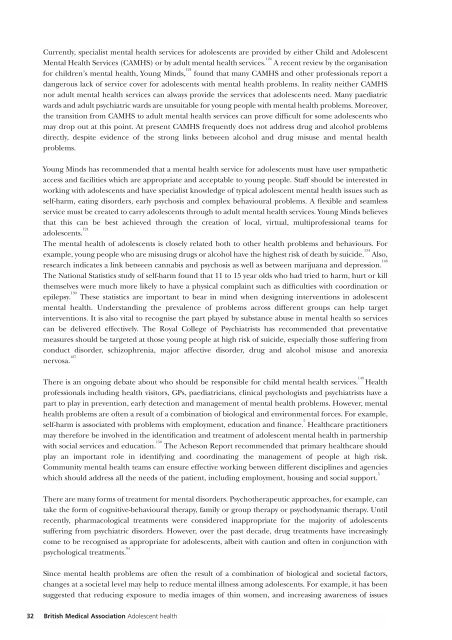Alcohol misuse: tackling the UK epidemic - London
Alcohol misuse: tackling the UK epidemic - London
Alcohol misuse: tackling the UK epidemic - London
You also want an ePaper? Increase the reach of your titles
YUMPU automatically turns print PDFs into web optimized ePapers that Google loves.
32<br />
Currently, specialist mental health services for adolescents are provided by ei<strong>the</strong>r Child and Adolescent<br />
Mental Health Services (CAMHS) or by adult mental health services. 124<br />
A recent review by <strong>the</strong> organisation<br />
for children’s mental health, Young Minds, 124<br />
found that many CAMHS and o<strong>the</strong>r professionals report a<br />
dangerous lack of service cover for adolescents with mental health problems. In reality nei<strong>the</strong>r CAMHS<br />
nor adult mental health services can always provide <strong>the</strong> services that adolescents need. Many paediatric<br />
wards and adult psychiatric wards are unsuitable for young people with mental health problems. Moreover,<br />
<strong>the</strong> transition from CAMHS to adult mental health services can prove difficult for some adolescents who<br />
may drop out at this point. At present CAMHS frequently does not address drug and alcohol problems<br />
directly, despite evidence of <strong>the</strong> strong links between alcohol and drug <strong>misuse</strong> and mental health<br />
problems.<br />
Young Minds has recommended that a mental health service for adolescents must have user sympa<strong>the</strong>tic<br />
access and facilities which are appropriate and acceptable to young people. Staff should be interested in<br />
working with adolescents and have specialist knowledge of typical adolescent mental health issues such as<br />
self-harm, eating disorders, early psychosis and complex behavioural problems. A flexible and seamless<br />
service must be created to carry adolescents through to adult mental health services. Young Minds believes<br />
that this can be best achieved through <strong>the</strong> creation of local, virtual, multiprofessional teams for<br />
adolescents. 124<br />
The mental health of adolescents is closely related both to o<strong>the</strong>r health problems and behaviours. For<br />
example, young people who are misusing drugs or alcohol have <strong>the</strong> highest risk of death by suicide. 134<br />
Also,<br />
research indicates a link between cannabis and psychosis as well as between marijuana and depression. 148<br />
The National Statistics study of self-harm found that 11 to 15 year olds who had tried to harm, hurt or kill<br />
<strong>the</strong>mselves were much more likely to have a physical complaint such as difficulties with coordination or<br />
epilepsy. 130<br />
These statistics are important to bear in mind when designing interventions in adolescent<br />
mental health. Understanding <strong>the</strong> prevalence of problems across different groups can help target<br />
interventions. It is also vital to recognise <strong>the</strong> part played by substance abuse in mental health so services<br />
can be delivered effectively. The Royal College of Psychiatrists has recommended that preventative<br />
measures should be targeted at those young people at high risk of suicide, especially those suffering from<br />
conduct disorder, schizophrenia, major affective disorder, drug and alcohol <strong>misuse</strong> and anorexia<br />
nervosa. 127<br />
There is an ongoing debate about who should be responsible for child mental health services. 149<br />
Health<br />
professionals including health visitors, GPs, paediatricians, clinical psychologists and psychiatrists have a<br />
part to play in prevention, early detection and management of mental health problems. However, mental<br />
health problems are often a result of a combination of biological and environmental forces. For example,<br />
self-harm is associated with problems with employment, education and finance. 5<br />
Healthcare practitioners<br />
may <strong>the</strong>refore be involved in <strong>the</strong> identification and treatment of adolescent mental health in partnership<br />
with social services and education. 150<br />
The Acheson Report recommended that primary healthcare should<br />
play an important role in identifying and coordinating <strong>the</strong> management of people at high risk.<br />
Community mental health teams can ensure effective working between different disciplines and agencies<br />
which should address all <strong>the</strong> needs of <strong>the</strong> patient, including employment, housing and social support. 5<br />
There are many forms of treatment for mental disorders. Psycho<strong>the</strong>rapeutic approaches, for example, can<br />
take <strong>the</strong> form of cognitive-behavioural <strong>the</strong>rapy, family or group <strong>the</strong>rapy or psychodynamic <strong>the</strong>rapy. Until<br />
recently, pharmacological treatments were considered inappropriate for <strong>the</strong> majority of adolescents<br />
suffering from psychiatric disorders. However, over <strong>the</strong> past decade, drug treatments have increasingly<br />
come to be recognised as appropriate for adolescents, albeit with caution and often in conjunction with<br />
psychological treatments. 94<br />
Since mental health problems are often <strong>the</strong> result of a combination of biological and societal factors,<br />
changes at a societal level may help to reduce mental illness among adolescents. For example, it has been<br />
suggested that reducing exposure to media images of thin women, and increasing awareness of issues<br />
British Medical Association Adolescent health
















